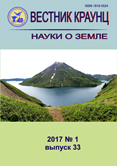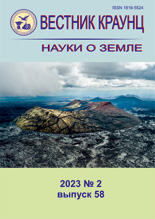Abstract
The basic fundamentals of spectral analysis of horizontal and vertical components of microseismic noise for studying the geological structure of dams are presented. The issues of constructing deep sections of three dynamic parameters of microseisms are considered. The aim of the work is to study the seismic reaction of soils during microseismic sounding of hydraulic structures. The main objectives of the research include the comparison of deep sections of soil reinforcement coefficients with sections of transmission ratios and data from other geophysical methods. As a result of microseismic sounding of three hydraulic structures, it was found out that the seismic reaction of the clay core of dams differs significantly from the surrounding soils. The amplification coefficients in the bedrock and dispersed soils of the aeration zone are characterized by minimal values. For water-saturated clays, these values are 5–10 times higher, which may indicate that the main reason for the increase in the level of microseismic noise is an increase in the overall porosity and moisture of soils. It is noted that the amplification coefficients of horizontal microseisms are more noise-resistant and detailed compared to the parameters of vertical microseisms. It is stated that deep sections of dynamic microseism parameters allow us to confidently distinguish the main elements of the structure of soil dams, as well as to identify probable zones of increased filtration.
References
Алешин А.С. Сейсмическое микрорайонирование особо ответственных объектов. М.: ООО «Светоч Плюс», 2010. 293 с. [Aleshin A.S. Seismic microdistricting of especially critical objects. Moscow: LLC «Svetoch Plus», 2010. 293 p. (in Russian)].
Горбатиков А.В., Цуканов А.А. Моделирование волн Рэлея вблизи рассеивающих скоростных неоднородностей. Исследование возможностей метода микросейсмического зондирования // Физика Земли. 2011. № 4. С. 96–112. https://doi.org/10.1134/S0002333711040077 [Gorbatikov A.V., Tsukanov A.A. Modeling of Rayleigh waves near the scattering velocity heterogeneities. Research opportunities microseismic sensing method //F izika Zemli. 2011. № 4. P. 96–112 (in Russian)].
Давыдов В.А. Спектральный анализ данных микросейсмических зондирований // Геофизика. 2015. № 1. С. 72–77 [Davydov V.A. The spectral analysis of data of microseismic sounding // Geofizika. 2015. № 1. P. 72–77 (in Russian)].
Давыдов В.А. Универсальный полевой геофизический приемник ОМАР-2 // Приборы и техника эксперимента. 2016а. № 6. С. 127–128 [Davydov V.A. Universal field geophysical receiver OMAR-2 // Instruments and Experimental Techniques. 2016a. № 6. P. 127–128 (in Russian)].
Давыдов В.А. Микросейсмическое зондирование грунтовых плотин на основе изучения ортогональных компонент колебаний // Инженерные изыскания. 2016б. № 5–6. С. 46–51 [Davydov V.A. Microseismic sounding of soil dams on the basis of analysis orthogonal components of oscillatings // Engineering research. 2016b. № 5–6. P. 46–51 (in Russian)].
Давыдов В.А. Малоглубинное сейсмическое зондирование на основе изучения эллиптичности микросейсм. Георесурсы. 2019. Т. 21. № 1. С. 78–85. https://doi.org/10.18599/grs.2019.1.78-85 [Davydov V.A. Shallow seismic sounding based on ellipticity analysis of microtremor //Georesursy. 2019. V. 21. № 1. P. 78–85].
Давыдов В.А., Федорова О.И., Байдиков С.В. Применение 1D–2D инверсий электромагнитных зондирований при изучении грунтовых плотин // Известия УГГУ. 2019. Вып. 2 (54). С. 72–79. https://doi.org/10.21440/2307-2091-2019-2-72-79 [Davydov V.A., Fedorova O.I., Baidikov S.V. Application of 1D–2D inversion of electromagnetic sounding in the study of ground water dam // News of the Ural State Mining University. 2019. Iss. 2 (54). P. 72–79 (in Russian)].
Давыдов В.А., Горшков В.Ю. Дистанционные индукционные зондирования плотин с изучением частотных эффектов // Гидротехническое строительство. 2022. № 5. С. 41–49. http://dx.doi.org/10.34831/EP.2022.62.39.008 [Davydov V.A., Gorshkov V.Y. Remote induction sounding of dams with the study of frequency effects // Hydraulic engineering construction. 2022. № 5. P. 41–49 (in Russian)].
Калинина А.В., Аммосов С.М., Волков В.А. Сейсмический шум: опыт применения в инженерно-геофизических исследованиях // Разведка и охрана недр. 2008. № 1. С. 32–34 [Kalinina A.V., Ammosov S.M., Volkov V.A. Seismic noise: experience of application in engineering and geophysical research // Razvedka i ohrana nedr. 2008. № 1. P. 32–34 (in Russian)].
Колесников Ю.И., Федин К.В. Прямое определение резонансных свойств верхней части разреза по микросейсмам: натурный эксперимент //Технологии сейсморазведки. 2017. № 3. С. 5–21. https://doi.org/10.18303/1813-4254-2017-3-5-21 [Kolesnikov Yu.I., Fedin K.V. Direct determination of the resonant properties of the upper part of the section by microseisms: a full-scale experiment // Tekhnologii seysmorazvedki. 2017. № 3. P. 5–21 (in Russian)].
Пупатенко В.В., Рябинкин К.С., Бронников А.К. и др. Опыт комплексирования микросейсмического и магнитотеллурического зондирования на участке северного фланга Центрального Сихотэ-Алинского разлома // Вестник КРАУНЦ. Серия: Науки о Земле. 2021. № 2. Вып. № 50. С. 84–94. https://doi.org/10.31431/1816-5524-2021-2-50-84-94 [Pupatenko V.V., Ryabinkin K.S., Bronnikov A.K. et al. Experience of integration of microseismic and magnetotelluric sounding on the site of the northern flank of the Central Sikhote-Alin fault // Vestnik KRAUNts. Nauki o Zemle. 2021. № 2 (50). P. 84–94 (in Russian)].
Рогожин Е.А., Горбатиков А.В., Степанова М.Ю. и др. Глубинное строение северо-западного окончания Кавказа по новым геолого-геофизическим данным // Физика Земли. 2020. № 6. С. 48–65. https://doi.org/10.31857/S0002333720060071 [Rogozhin E.A., Gorbatikov A.V., Stepanova M.Yu. et al. Deep Structure of the Northwestern Termination of the Caucasus from New Geological and Geophysical Data // Izvestiya, Physics of the Solid Earth. 2020. V. 56. № 6. P. 772–788 https://doi.org/10.1134/S1069351320060075].
Табулевич В.Н. Комплексные исследования микросейсмических колебаний. Новосибирск: Наука, 1986. 152 с. [Tabulevich V.N. Complex studies of microseismic oscillations. Novosibirsk: Nauka, 1986. 152 p. (in Russian)].
Федорова О.И., Давыдов В.А. Диагностика грунтовых гидротехнических сооружений электрическими и сейсмическими методами на примере Ельчевской плотины // Водное хозяйство России: проблемы, технологии, управление. 2014. № 6. С. 44–55 [Fedorova O.I., Davydov V.A. Diagnostics of ground water-work facilities with electric and seismic methods with the Elchevsk dam as a study case // Water sector of Russia: problems, technologies, management. № 6. P. 44–55 (in Russian)].
Федорова О.И., Давыдов В.А., Байдиков С.В. и др. Применение геоэлектрического мониторинга при изучении грунтовых плотин // Геоэкология. Инженерная геология, гидрогеология, геокриология. 2017. № 1. С. 84–92 [Fedorova O.I., Davydov V.A., Baidikov S.V. et al. Application of geoelectric monitoring in the study of soil dams // Geoekologiya. Inzhenernaya geologiya, gidrogeologiya, geokriologiya. 2017. № 1. P. 84–92 (in Russian)].
Яновская Т.Б. К теории метода микросейсмического зондирования // Физика Земли. 2017. №. 6. С. 18–23. https://doi.org/10.7868/S0002333717060072 [Yanovskaya T.B. On the theory of the microseismic sounding method // Izvestiya, Physics of the Solid Earth. 2017. V. 53. № 1. P. 819–824. https://doi.org/10.1134/S1069351317060076].
Bath M. Spectral analysis in geophysics. Developments in Solid Earth Geophysics. Amsterdam: Elsevier Science Publishing, 1974. 579 p.
Chatelain J.C., Guillier B., Cara F. et al. Evaluation of the influence of experimental conditions on H/V results from ambient noise recordings // Bulletin of Earthquake Engineering. 2008. №. 6. P. 33–74. https://doi.org/10.1007/s10518-007-9040-7
Davydov V.A., Baidikov S.V., Gorshkov V.Y. et al. Geophysics Methods in Electrometric Assessment of Dams // Power Technology and Engineering. 2016. V. 50. № 2. P. 168–175. https://doi.org/10.1007/s10749-016-0678-7
Fäh D., Kind F., Giardini D. A theoretical investigation of average H/V ratios // Geophysical Journal International. 2001. V. 145. № 2. P. 535–549. https://doi.org/10.1046/j.0956-540x.2001.01406.x
Haghshenas E., Bard P.Y., Theodulidis N. et al. Empirical evaluation of microtremor H/V spectral ratio // Bulletin of Earthquake Engineering. 2008. V. 6. P. 75–108. https://doi.org/10.1007/s10518-007-9058-x
Nakamura Y. A method for dynamic characteristic estimation of subsurface using microtremor on the ground surface.// Quarterly Report of Railway Technical Research Institute. 1989. V. 30. № 1. P. 25–33.
Nakamura Y. What is the Nakamura method? //Seismological Research Letters. 2019. V. 90. № 4. P. 1437–1443. https://doi.org/10.1785/0220180376
Parolai S., Galiana-Merino J.J. Effect of Transient Seismic Noise on Estimates of H/V Spectral Ratios // Bulletin of the Seismological Society of America. 2006. V. 96. № 1. P. 228–236. https://doi.org/10.1785/0120050084

This work is licensed under a Creative Commons Attribution-NonCommercial 4.0 International License.
Copyright (c) 2023 В.А. Давыдов

